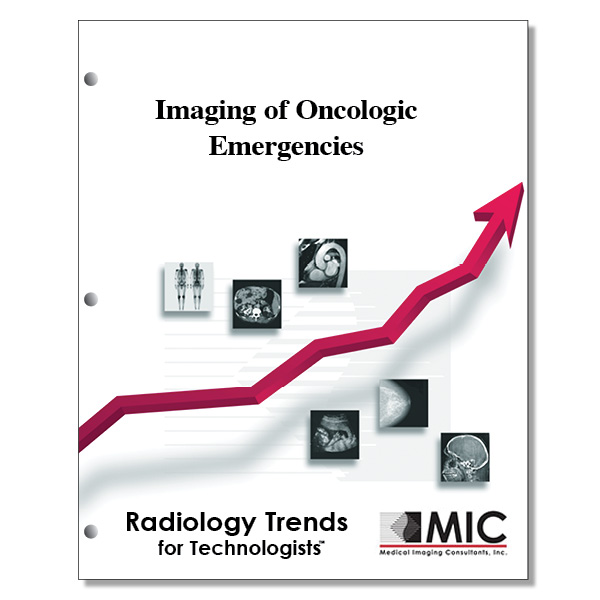

Imaging of Oncologic Emergencies
Presented are oncologic emergencies in which radiology plays a key role in timely diagnosis and patient care.
Course ID: Q00403 Category: Radiology Trends for Technologists Modalities: CT, Radiation Therapy, Radiography, Vascular Interventional4.25 |
Satisfaction Guarantee |
$39.00
- Targeted CE
- Outline
- Objectives
Targeted CE per ARRT’s Discipline, Category, and Subcategory classification for enrollments starting after May 25, 2023:
[Note: Discipline-specific Targeted CE credits may be less than the total Category A credits approved for this course.]
Computed Tomography: 2.75
Procedures: 2.75
Head, Spine, and Musculoskeletal: 0.75
Neck and Chest: 1.00
Abdomen and Pelvis: 1.00
Magnetic Resonance Imaging: 4.25
Patient Care: 1.50
Patient Interactions and Management: 1.50
Procedures: 2.75
Neurological: 1.00
Body: 1.75
Radiography: 4.25
Patient Care: 1.50
Patient Interactions and Management: 1.50
Procedures: 2.75
Head, Spine and Pelvis Procedures: 1.00
Thorax and Abdomen Procedures: 1.75
Registered Radiologist Assistant: 4.25
Procedures: 4.25
Abdominal Section: 1.50
Thoracic Section: 1.25
Neurological, Vascular, and Lymphatic Sections: 1.50
Radiation Therapy: 4.25
Patient Care: 2.00
Patient and Medical Record Management: 2.00
Procedures: 2.25
Treatment Sites and Tumors: 2.25
Outline
- Introduction
- Imaging Approach
- Central Nervous System Emergencies
- Cerebral Herniation
- Carcinomatous Meningitis
- Spinal Cord Compression
- Thoracic Emergencies
- Central Airway Obstruction
- Esophagorespiratory Fistula
- Massive Hemoptysis
- Pulmonary Embolism
- Superior Vena Cava Syndrome
- Pericardial Tamponade
- Abdominal Emergencies
- Uncontrolled Intraabdominal Hemorrhage
- Intestinal Emergencies
- Urinary Tract Obstruction
- Treatment-related Emergencies
- Conclusions
Objectives
Upon completion of this course, students will:
- list the classifications of oncologic emergencies
- specify the reasons cancer patients visit the emergency room
- explain which oncologic emergencies require imaging studies
- state what tumors are associated with ATLS
- differentiate between the percentage of primary and metastatic brain tumors
- list the types of brain herniation associated with increased intracranial pressure
- list the symptoms of intracranial pressure
- articulate the reasons for increased detection of metastatic involvement of the leptomeninges
- select the most common mechanism of spread in carcinomatous meningitis
- name the symptoms of carcinomatous meningitis
- understand the best imaging modality for diagnosis of leptomeningeal carcinomatosis in the absence of malignant cells in fluid samples
- rank the areas of the spine affected by malignant compression
- state the most common symptom of malignant SCC
- verbalize which cancer is the most common cause of central airway obstruction
- list the types of malignancies that can cause central airway obstruction
- understand how obstruction of the upper airway can cause severe acute respiratory failure
- summarize the symptoms of central airway obstruction
- recognize the clinical signs of malignant central airway obstruction
- state the treatment options for malignant central airway obstruction
- indicate the two types of radiation therapy used to treat malignant central airway obstruction
- discuss the use of tracheal stent placement
- list the common malignant causes of esophagorespiratory fistula
- explain what area of the esophagus is most highly affected by esophagorespiratory fistula
- name the clinical features of esophagorespiratory fistula
- indicate the causes for hemoptysis due to lung metastases
- list the common malignancies that may cause tumor embolism
- express the clinical presentation in patients with pulmonary embolism
- categorize catheter-based interventions for acute pulmonary embolism
- match the percentage and types of cancers causing superior vena cava syndrome
- distinguish between the types of SVC syndrome onset
- specify the cause of pericardial tamponade in oncology patients
- name the most common clinical finding in patients with cardiac tamponade
- state the medical signs associated with Beck’s triad
- discuss the imaging options available to guide pericardial fluid drainage
- list the risk factors for intramural hemorrhage and subsequent spontaneous rupture
- express the common bowel-related emergencies in cancer patients
- distinguish between the percentages of ovarian and colorectal cancer patients that may develop acute intestinal obstruction
- explain the pathophysiologic events related to acute bowel obstruction
- name the categories of intussusceptions
- list the cancers associated with bladder outlet obstruction
